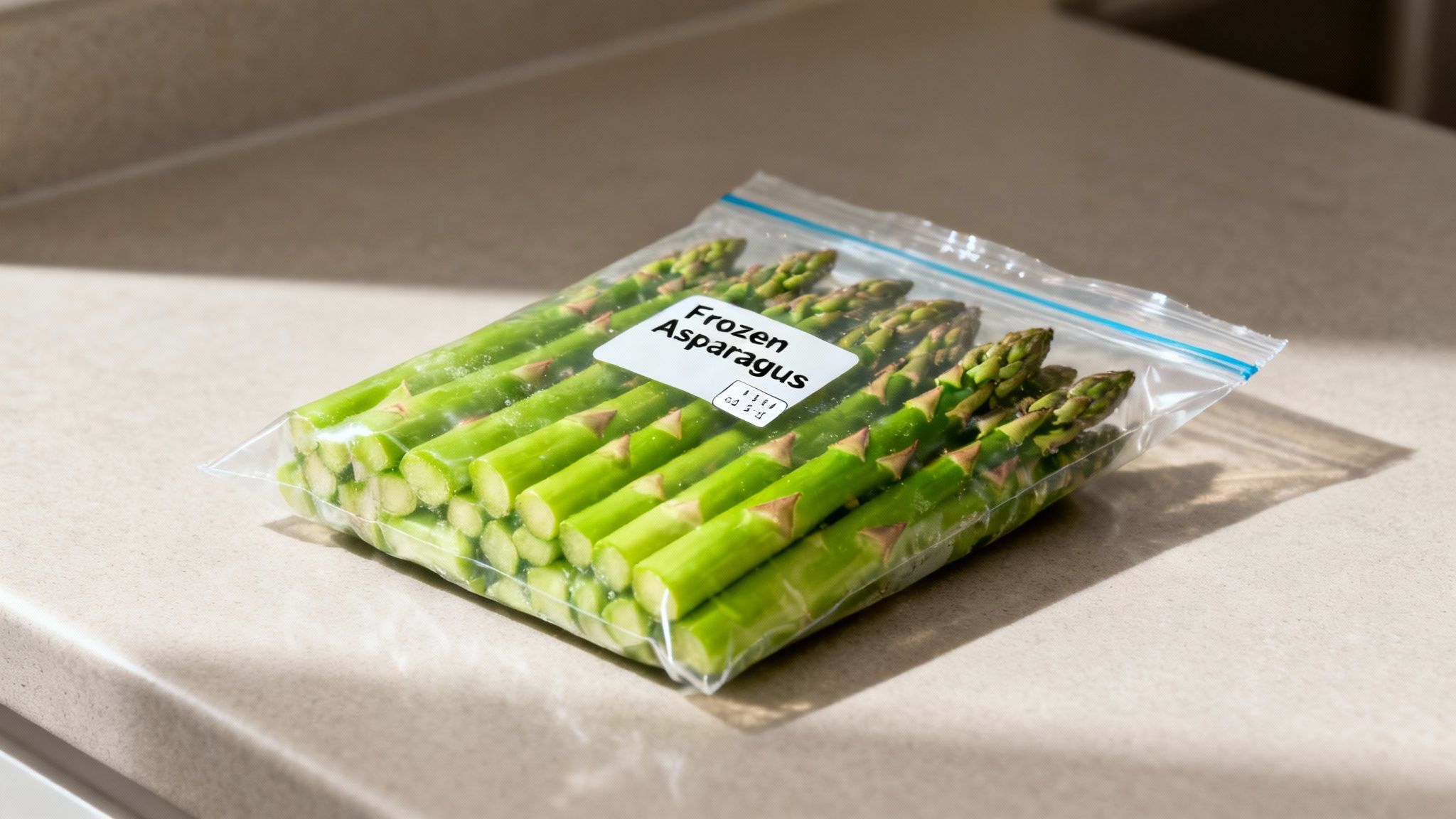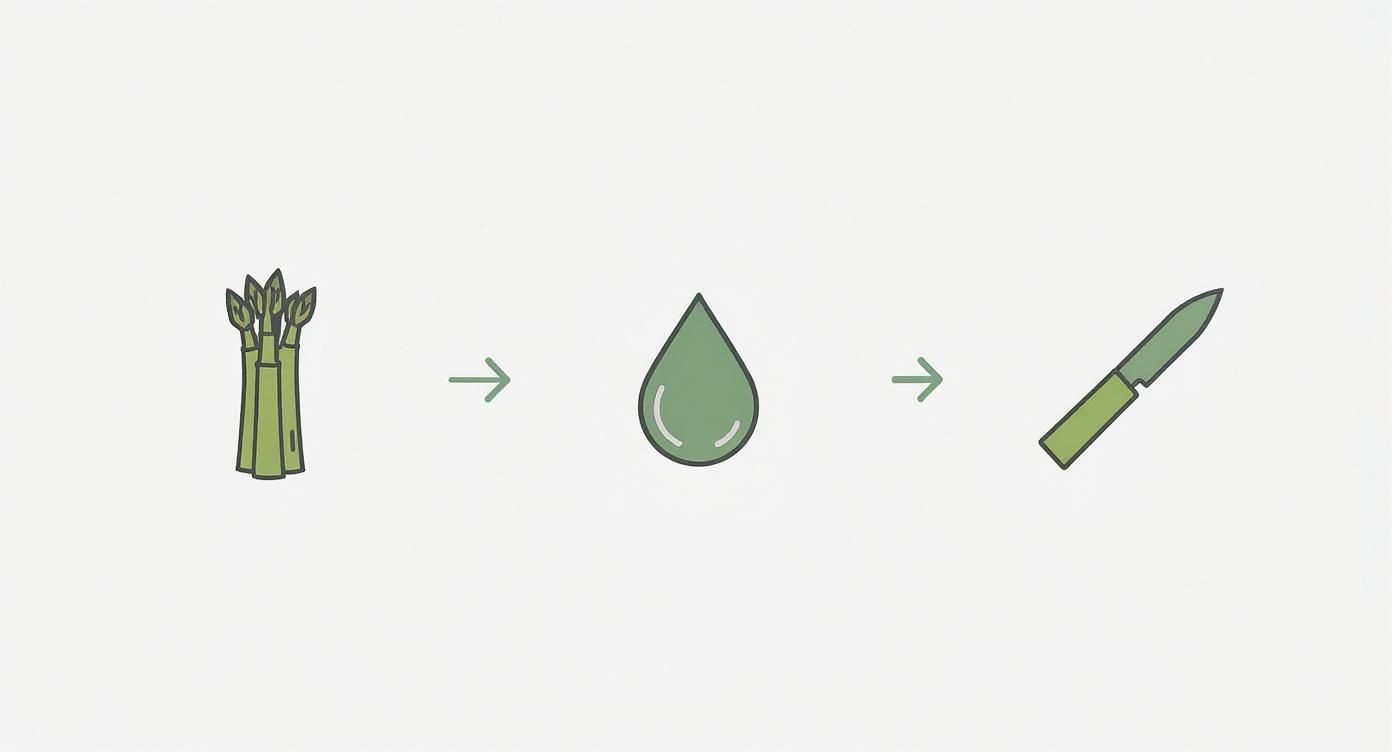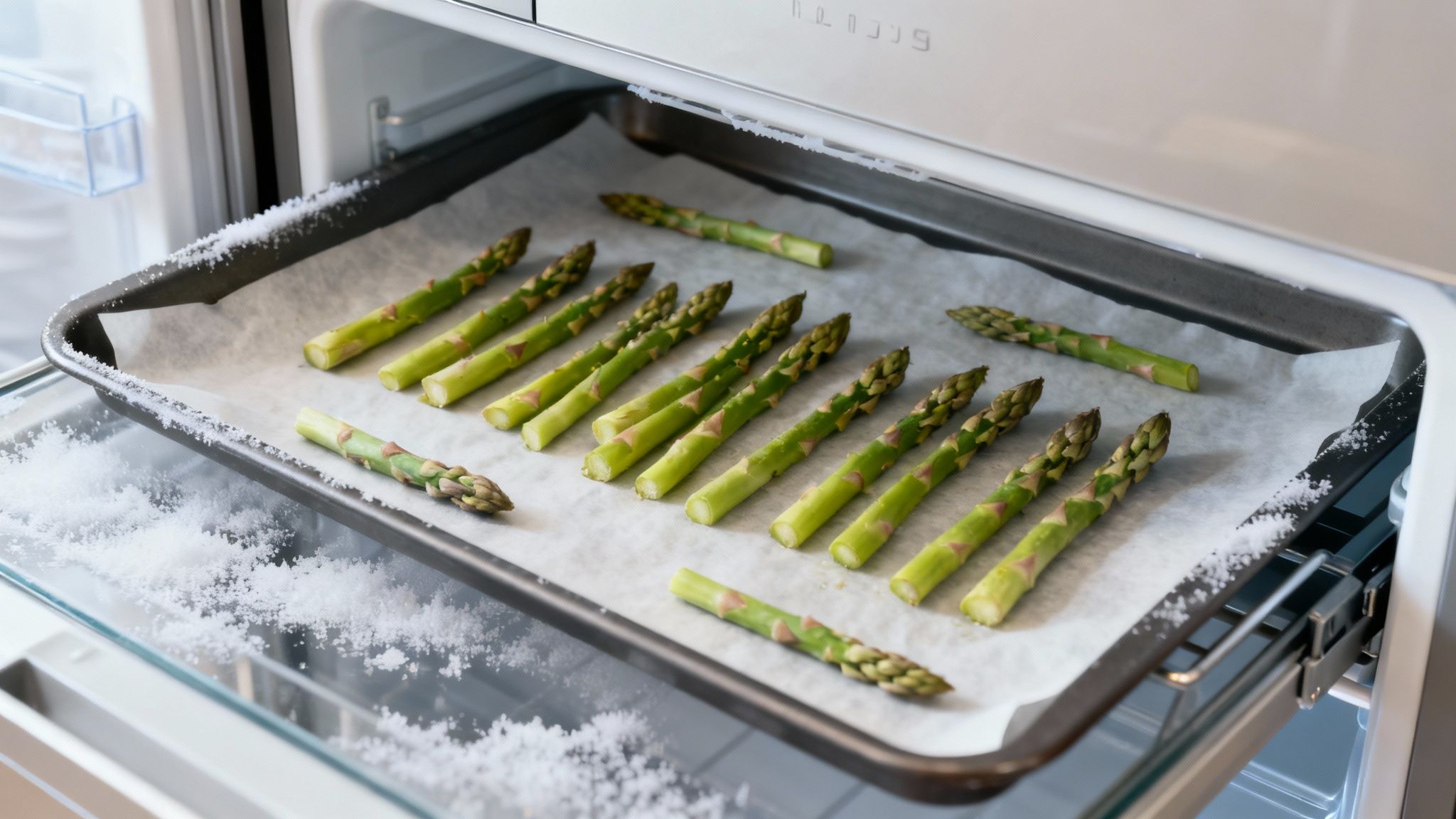Can Fresh Asparagus Be Frozen? Your Ultimate Guide
Yes, you absolutely can freeze fresh asparagus. In fact, it’s a brilliant way to capture that peak-season flavor and enjoy it for months to come. The real secret to avoiding those sad, mushy spears you might be picturing is a simple but non-negotiable step: blanching. Trust me, this one little trick makes all the difference in locking in that vibrant color, crisp texture, and all the good stuff inside.
Why Freezing Asparagus is a Smart Move

If you’ve ever found a great deal on a huge bundle of fresh asparagus at the farmer’s market or had a garden that produced more than you could possibly eat, you know the dilemma. Freezing is the perfect solution. When done right, frozen asparagus holds onto so much of its fresh quality, making it an incredibly versatile ingredient to have on hand for future meals.
This isn’t just a home cook’s hack; it’s a massive global practice. While we love our asparagus fresh, a huge portion of the world’s harvest—about one-third—is processed for freezing and canning. In the U.S. alone, roughly half of the entire crop is processed, mostly for freezing. That just goes to show how reliable this method is for preservation on a huge scale. You can dig into the details of how asparagus is processed worldwide to see just how common it is.
Key Takeaway: Freezing fresh asparagus is not only possible but also incredibly practical. By following a few key steps, you can sidestep common pitfalls like freezer burn and texture loss, guaranteeing you’ll have delicious asparagus ready to go all year long.
Here’s a quick look at the core steps for getting freezing right. Each one plays a crucial role in the final result.
Asparagus Freezing At a Glance
This table breaks down the essentials of the process. Think of it as your cheat sheet for perfect frozen asparagus every time.
| Step | Action | Why It Matters |
|---|---|---|
| Blanching | A quick boil followed by an ice bath. | Deactivates enzymes that cause decay, locking in color, flavor, and texture. |
| Proper Storage | Use airtight containers or vacuum-sealed bags. | Prevents dreaded freezer burn and keeps the asparagus fresh for up to a year. |
| Flash Freezing | Freeze spears individually on a baking sheet first. | A simple trick to stop the spears from clumping into a solid, icy block. |
Getting these three things right is the foundation for success. In the next sections, we’ll walk through exactly how to nail each part of the process.
Getting Your Asparagus Ready for the Freezer
Believe it or not, the secret to fantastic frozen asparagus starts long before you even touch the freezer door. It all begins at the grocery store or, even better, the farmer’s market. The quality you pick from the start makes all the difference.
You’re looking for stalks that are firm to the touch with a vibrant, uniform green color. Check the tips—they should be tightly closed and compact, almost like a little bud. If you see any bundles that look limp, wilted, or are starting to turn yellow, walk away. Those are signs of age, and they just won’t freeze well.
How to Pick the Best Spears
I get asked about thickness a lot. Does it matter? Not for quality, but it does for prep. Both skinny and chunky spears freeze beautifully, so it really comes down to what you like. Personally, I aim for medium-thick stalks. They seem to hit the sweet spot—sturdy enough to handle the blanching process without turning to mush, but still wonderfully tender.
Once you’ve got your asparagus home, the prep work is simple but super important. First up, give the spears a good rinse under cool running water. This gets rid of any sand or grit, especially around those delicate tips.
My Two Cents: Don’t be tempted to soak your asparagus. A quick, thorough rinse is all it takes. Letting them sit in water can make them waterlogged, which is exactly what you want to avoid right before freezing.
After a good wash, pat the spears completely dry with a clean kitchen towel or some paper towels. Now for the most critical step: trimming off those woody ends. The bottoms are tough and fibrous, and freezing only makes them tougher.
There’s a simple trick to find the perfect spot to trim. Just take a single spear, hold it with both hands, and gently bend it. It will naturally snap right where the tender part of the stalk meets the woody base. Toss that tough end. You can do this for every single spear, or you can use your first snap as a guide, line up the rest of the bunch, and chop them all at once with a knife. Easy. This little step ensures every piece you pull from the freezer is perfectly tender.
Mastering the Blanching Process
If there’s one step you absolutely cannot skip when freezing fresh asparagus, it’s blanching. This is the secret weapon for locking in that vibrant green color, crisp-tender bite, and all the good-for-you nutrients. It might sound like a fancy chef technique, but it’s really just a quick dunk in boiling water followed by an immediate ice bath.
So, why is this so critical? Blanching instantly halts the enzyme activity inside the asparagus. If you let these enzymes do their thing, they’re the culprits that make frozen vegetables lose their flavor, color, and texture over time. A few extra minutes of prep now guarantees that just-picked freshness later.
This handy infographic lays out the simple workflow you’ll want to follow before you even get the water boiling.

As you can see, a great result starts with good prep. Choosing quality spears, giving them a good rinse, and snapping off those woody ends first will make the whole process go off without a hitch.
Perfecting Your Blanching Times
Timing is everything here, and it all comes down to how thick your asparagus spears are. If you overdo it, you’ll end up with mushy asparagus before it even sees the freezer. But if you underdo it, those pesky enzymes won’t be fully deactivated.
Here’s a reliable guide I always stick to:
- Thin Spears: These skinny guys need just 2 minutes in the pot.
- Medium Spears: This is the sweet spot. Aim for 3 minutes for that perfect crisp-tender texture.
- Thick Spears: Give these bigger stalks a full 4 minutes to make sure they’re blanched all the way through.
Seriously, set a timer. Guessing is the fastest way to miss the mark. You’re looking for the asparagus to turn a brilliant green and be just tender enough that a fork can pierce it with a little bit of resistance. This same principle works for lots of other garden veggies, too—you can learn more in our guide on how to freeze fresh zucchini, where blanching is just as important.
Setting Up Your Blanching Station
To make this process seamless, get your station ready before you begin. You just need two key things: a large pot of roiling, boiling water and a big bowl of ice water. I like to have them right next to each other on the counter.
Use a slotted spoon or a spider strainer to swiftly move the asparagus from the boiling water straight into the ice bath. This step, known as “shocking,” is what immediately stops the cooking process in its tracks. Let the spears hang out in the ice water for the same amount of time you blanched them. So, if they boiled for 3 minutes, they need to chill for 3 minutes.
Expert Tip: Don’t crowd the pot! Blanch in small batches to keep the water temperature consistently high. If you dump too much asparagus in at once, the temperature will drop, throwing off your timing and leaving you with unevenly cooked spears.
Once the asparagus is thoroughly chilled, drain it well. Now for the final, crucial step: pat the spears completely dry with a clean kitchen towel or paper towels. Any leftover moisture is your enemy in the freezer—it’s what leads to ice crystals and freezer burn. Taking a moment to dry them properly is your ticket to perfectly preserved asparagus.
How to Flash Freeze for Better Long-Term Storage

After you’ve blanched and carefully dried your asparagus, there’s one more quick step that makes all the difference. It’s called flash freezing, and it’s my secret weapon for preventing those beautiful spears from clumping into one giant, solid ice block in the freezer. Nobody wants an asparagus iceberg.
The process itself is incredibly straightforward. Just grab a baking sheet that will fit comfortably in your freezer and spread the dry, blanched asparagus spears across it in a single layer. The key is to make sure they aren’t touching.
Pop that baking sheet into the freezer for about one to two hours. You’ll know they’re ready when each spear is frozen solid. This simple trick freezes each piece individually, which is a total game-changer when you just want to grab a handful for a recipe later on.
Choosing the Right Storage Container
Once your asparagus is rock solid, it’s time to move it to its long-term home. Your choice of container is what stands between you and freezer burn, so it’s worth getting this part right. You’ve got a few solid options:
- Freezer Bags: These are the go-to for most people. They’re affordable, easy to find, and get the job done. If you use them, make sure to squeeze out as much air as you possibly can before sealing the bag. Less air means fewer ice crystals.
- Vacuum-Sealed Bags: This is my top recommendation, hands down. A vacuum sealer removes virtually all the air, creating the perfect environment for long-term storage. It’s an investment upfront, but it dramatically extends the life of your frozen foods and keeps their quality far superior to a standard bag. This technique works wonders for other vegetables, too; we use a similar method in our guide on whether carrots can be frozen.
Final Tip: No matter what container you pick, don’t skip the most crucial final step—labeling. Grab a permanent marker and write the date right on the bag. Your frozen asparagus will be at its best for 8 to 12 months, and a clear date saves you from guessing games later.
This interest in preserving vegetables at home is part of a much bigger picture. The global frozen green asparagus market is projected to hit $750 million by 2033, which shows a massive consumer demand for convenient, healthy options. It turns out that modern freezing techniques are so effective they lock in much of the original fiber and vitamins. You can learn more about the frozen asparagus market growth and see why it’s becoming such a popular choice in kitchens everywhere.
Cooking with Your Home-Frozen Asparagus
Seriously, this is a game-changer. Tossing those frozen spears directly into a hot pan is the secret to keeping them firm and snappy. When you thaw asparagus beforehand, the ice crystals melt and turn to water, which is a one-way ticket to a soft, sometimes even soggy, final product. Nobody wants that.
This “straight-from-the-freezer” approach works like a charm for so many dishes. You can scatter your frozen asparagus onto a sheet pan with other veggies for a super-fast roast or just toss it into a sizzling stir-fry during the last few minutes of cooking.
Simple Meal Ideas
Here are a few of my favorite ways to put frozen asparagus to work where it truly shines:
- Quick Frittatas or Quiches: Chop up the frozen spears and mix them right into your egg base before baking. They cook perfectly and add a fantastic pop of green.
- Creamy Risotto or Pasta: Stir the asparagus pieces into your dish during the final five minutes of cooking. They’ll become perfectly crisp-tender without getting lost in the sauce.
- Flavorful Soups: For a burst of color and nutrients, just drop them into a simmering soup or stew near the very end. They’ll heat through without turning to mush.
Think of it this way: by cooking from frozen, you’re basically steaming the asparagus in its own moisture. This is what helps it keep that fantastic, satisfying snap. It’s the easiest trick I know for getting great results every single time.
Once you’ve got the hang of freezing your asparagus, you’ll find you have an incredibly versatile ingredient ready to go at a moment’s notice. For more ideas on stocking your kitchen with healthy, long-lasting ingredients, including some great gluten-free food staples, there are plenty of excellent resources out there to explore.
Common Questions About Freezing Asparagus
Even when you have the process down, a few questions always seem to pop up. Let’s walk through some of the most common ones I hear, so you can feel totally confident freezing your fresh asparagus.
Can I Freeze Asparagus Without Blanching It First?
I get this question all the time. While you technically can skip blanching, I really advise against it.
Think of it this way: raw asparagus has active enzymes that don’t just go dormant in the freezer. They keep working, breaking down the vegetable’s structure, flavor, and color. The result? You’ll pull out a bag of dull, mushy, and frankly, flavorless spears later on. Blanching is the single most important step to lock in that vibrant, fresh-picked quality.
How Long Will Frozen Asparagus Last?
When you’ve blanched it properly and stored it in a good airtight freezer bag (or even better, a vacuum-sealed one), your asparagus will stay in prime condition for 8 to 12 months.
It’s still safe to eat after that, but you’ll likely start to notice a slow decline in its texture and flavor.
Why Did My Frozen Asparagus Turn Out Mushy?
Ah, the dreaded mushy asparagus. This almost always comes down to one of two culprits: over-blanching or thawing before you cook it.
If you blanch the spears for too long, you’re essentially pre-cooking them, which leads to a soft texture. The other common mistake is letting it thaw on the counter. As the ice crystals melt, the asparagus becomes waterlogged and limp.
The best way to avoid mushy asparagus is to cook it straight from the freezer. Just toss the frozen spears right into the pan or pot.
This whole process of managing ice crystals to preserve texture isn’t unique to vegetables. It’s the same science behind why some foods freeze better than others. We dive into a similar topic in our guide on if Greek yogurt can be frozen.
Ready to elevate your home dining without the prep work? Culinary Collective Atl offers personalized private chef services to bring gourmet meals right to your kitchen. Discover your custom menu at https://www.theculinarycollectiveatl.com.





